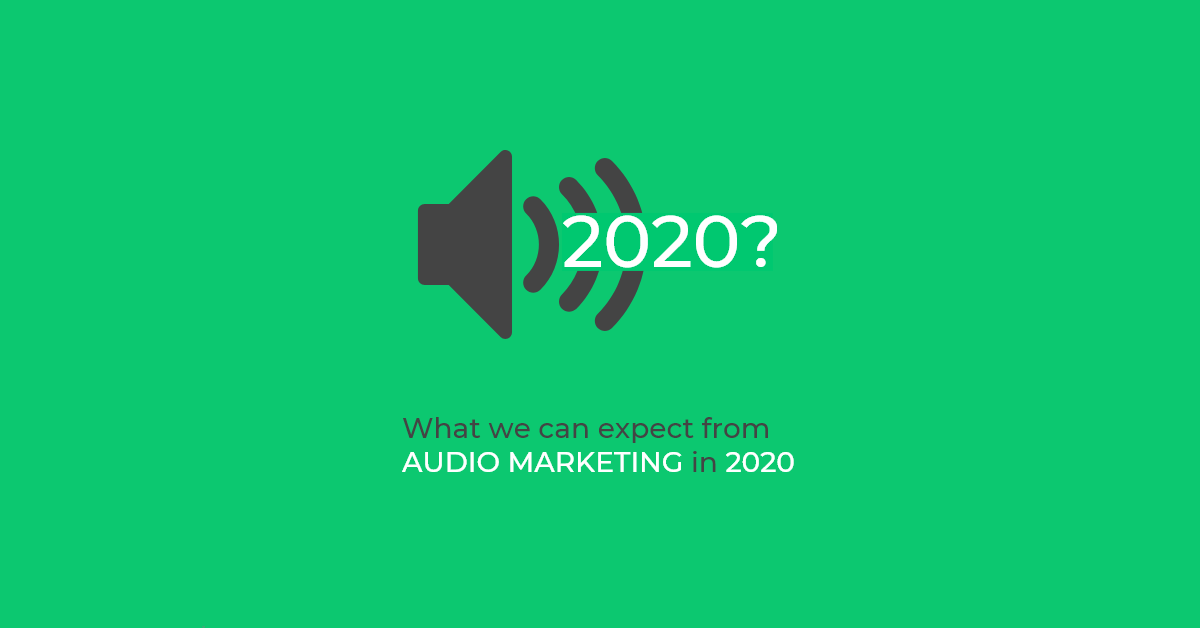What We Can Expect From Audio Marketing in 2020

This article was originally published in Adweek.
The importance of brand experience has jumped from a low-ranking priority straight to top of mind. Brands are now asked to tap into their audience’s subtle and shifting feelings while showcasing their own. It’s the kind of stage, where everything is set up for audio branding to steal the show.
There are hardly any common touchpoints in the modern marketing scene where sound isn’t either the leading sensory element or at least an eloquent side character sparking emotions. However, since we are living in an omnichannel world, cultivating the same experience at different settings is where the plot thickens. Creating effective and consistent audio is more important than ever.
Luckily, tons of new research emerged on sound and its influence in an advertising and marketing setting. Using them as a reference, I’m making the following predictions on how to script an audio strategy that will turn your brand into a multisensory masterpiece come the new decade.
Audio in social media stories will deliver
As far as digital touchpoints go, Facebook and Instagram stories are the high streets for driving ad engagement with audio. A Facebook study confirmed that 80% of stories with voice-over or music propelled better lower-funnel results than ads without sound.
Not only does this underline the value of audio with a heavy marker, but the nature of the beast that is the social media calls for poise and penmanship. It’s a fast-paced environment, where attention is won or lost in a matter of milliseconds and the dollars spent can vanish in vain with one casual decision.
In such a cluttered space, ads that ripple and resonate in canon will have the best chance of standing out. The sonic elements in your ad must be designed with similar vigilance and intent as the visuals. Melodic syncopation, intensity, and voice-overs in conjunction with visual hooks allow you to steer the viewer’s attention to the key messages.
Brand context will make or break an audio ad
This time next year, brands that manage to turn their offering from a scripted punchline into an instrument for the listening experience will be the talk of the town.
The findings from Radiocentre’s study Hear and Now stated that listeners are able to assimilate the details of radio ads in the middle of their chores. In fact, advertising that directly relates to tasks they are participating in, builds engagement and long-term memory encoding.
Ads that are bespoke to the audience’s surroundings will make a big difference. The creative starting point should be: ‘At what moment and place will the message resonate the most and how does our brand apply there?’ Crystallizing audience segmentation based on their activities and can help audio advertisers change their course of campaigns on a dime.
Whereas paying attention to audio’s relationship with other senses smoothens the delivery of the message, the way your brand is introduced puts the exclamation mark on it. This will be especially important for those looking to tune up their voice marketing.
Didactic use cases for smart speakers will deliver
The voice shopping trend is waning. In fact, purchasing with smart speakers experienced a significant drop from last year, as 24% of respondents in this year’s Dashbot survey said they have bought something through their device compared to 43% in 2018.
When you think about it, the user interface of voice shopping doesn’t deliver much information for buying a new product as quickly and intuitively as shopping on a screen does. You need to do your research before buying. Increasing privacy and security concerns aren’t actually helping, either.
This isn’t just a challenge for the manufacturers, brands need to do their bit, too. New use cases should be designed to amplify trust toward the company and its offering.
Consider the successful recipe of branded podcasts. They tell stories on themes and causes, which the host company is out to address. It’s about informing over straight-up advertising, and it has helped many brands topple trust barriers and open their agenda in a relatable way. Whereas with podcasts where the audience is asked to stand by and listen, smart speakers allow direct two-way interaction.
Do make sure you’re letting your audience ask first. Anticipate what they might want to know about your offering. As we learned previously, content that relates to the listeners’ activity helps them engross what you are saying.
Combining data with creativity will lead to success
This year saw audio branding make more headlines than ever, with names like Mastercard at the forefront. With such heavyweights in a growing number of industries now exploring their sonic identities, neglecting this trend might turn out costly. To achieve the most bang for your buck, you need to be effective and consistent even with the most abstract things, like feelings and values.
The job is easier said than done. Audio marketing has evolved so much in recent years that the wealth of options available is huge. From artist collaborations to custom music, the growth of the audio market has boomed to meet this increased demand. Whether it’s a provocative licensed track or a bespoke piece of music tailored to a specific setting, understanding what it says about your brand is key.
To succeed, you have to uncover the answers to these questions: Is your audio in-tune with your brand identity and other sensory assets within each touchpoint? Are you aware of your audience’s mindset and behavior there? How do your competitors navigate these spaces?
When these sonic stones are turned, it’s much easier to approach the creative part. The best way to measure the creativity of your audio branding is to analyze its emotional performance and make yourself clear which ingredients lead to affection or alienation. With clear audio do’s and don’ts in place, you have unique building blocks for an audio brand that suits and strikes at every situation and setting.





